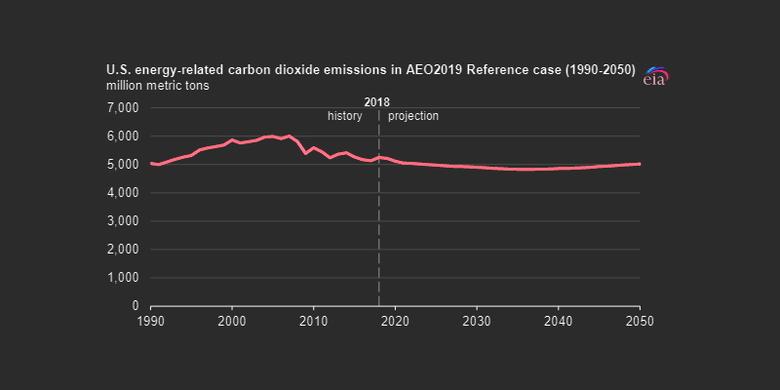
U.S. RENEWABLES + GREENHOUSE

ENERGYCENTRAL - The U.S. Energy Information Administration (EIA) is changing its tune on the rise of renewable energy, projecting for the first time in its Annual Energy Outlook that renewable energy will double its share of total generation and dash past natural gas as the country's leading electricity source before 2050.
But the agency paints a deeply troubling picture for the country's greenhouse gas emissions, with carbon pollution dipping briefly this decade, increasing in the 2030s, and falling only 4% overall by 2050, The Hill reports.
"Total U.S. energy-related carbon dioxide emissions resume modest growth in the 2030s, driven largely by increases in energy demand in the transportation and industrial sectors," the EIA concludes. "By 2050, they remain 4% lower than 2019 levels."
"This projection of relentless climate pollution is nothing short of terrifying," the U.S. Center for Biological Diversity said in a statement. "With Trump officials crippling emissions rules, climate-friendly lawmakers must build support for truly bold policies that avert the bleak future predicted by the EIA. We need much stronger measures."
The agency's emission projections come alongside a primary model scenario that shows renewables overtaking gas-generated electricity in 2045, Greentech Media states. In its "low renewables cost" scenario, the crossover hits in the 2030s. Those numbers represent a major change in just 12 months.
In last year's Outlook, "the EIA put natural gas at 39% of the power mix in 2050 under its base-case scenario, far outpacing renewables at 31," Greentech notes. But just 12 months later, "that prediction has been turned on its head: Renewables are now forecast to account for 38% of electricity in 2050 (up from 19% today), while natural gas will see its share drop to 36% (from 37% today)."
"We see renewables as the fastest-growing source of electricity generation through 2050, as cost declines make them economically competitive beyond the expiration of existing federal and state policy supports," said EIA Administrator Lisa Capuano.
"The EIA has long been known for its implausibly conservative predictions about renewable energy," Greentech says. And against that history, "the EIA's new take on renewables is striking. Even in a country awash in extremely cheap natural gas, and with a climate change denier running the show, the inevitable centrality of renewable electricity has been acknowledged by the main government agency responsible for energy analysis."
Even if that's no surprise to the U.S. renewable energy industry, the industry newsletter adds, "the implications are still big: Solar and wind will claim all of the market share gains in the expanding American power market over the coming three decades, with natural gas, nuclear, and coal all slipping—dramatically in the case of the latter two."
While wind accounted for 38% of U.S. renewable electricity supply last year, moving past hydroelectricity, the EIA sees solar dominating over the longer haul, rising from 15 to 46% by mid-century while wind declines to 33%.
However, "even acknowledging the ongoing competitiveness gains for renewables, the EIA does not paint a doomsday scenario for nuclear and coal," Greentech writes. "Instead, it sees their market positions deteriorating rapidly through the mid-2020s as older plants are retired, but then stabilizing afterward as more 'economically viable' plants remain in service."
The EIA also takes what Greentech calls the "conservative view" that electric vehicle adoption will have only a limited impact on U.S. electricity demand, citing a "lack of market evidence to date that would indicate a significant increase in U.S. consumer preference for EVs." The agency adds that "both vehicle sales and utilization would need to increase substantially for EVs to raise electric power demand growth rates by more than a fraction of a percentage per year."
Meanwhile, the EIA projects the U.S. continuing to set annual crude oil production records through the mid-2020s, remaining a net energy exporter through at least 2050, and increasing its natural gas production through mid-century. It sees behind-the-meter solar accounting for just 4% of electricity generation in 2050.
-----
This thought leadership article was originally shared with Energy Central's Clean Power Community Group. The communities are a place where professionals in the power industry can share, learn and connect in a collaborative environment. Join the Clean Power Community today and learn from others who work in the industry.
-----












